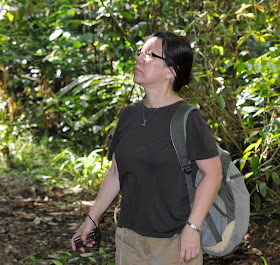The best places to see wildlife on the Lower Kinabatangan are not, usually, on the busy main river itself (the same is true of the Amazon). Quieter stretches, along a tributary or in an isolated former meander still connected to the main river by a narrow channel - an oxbow lake, so called because of it's typically arched shape - are likelier spots for some of the shyer forest creatures.
For others there is nothing or it but to get out of the boat and head into the forest on foot.
Lord Cranbrook has arranged a brief trip into a forest patch being studied as part of an ongoing survey of the local orangutan population. The orangs, not surprisingly, choose to be elsewhere during our hike.
A walk, of course, is the best way to appreciate details, including beautiful (and unidentified, at least by me) forest flowers...
...distinctive fruits in the undergrowth...
...delicate fungi rising out of the leaf litter (this may be a species of Leucocoprinus, perhaps L. fragilissimus, but don't quote me)...
...delicate fungi rising out of the leaf litter (this may be a species of Leucocoprinus, perhaps L. fragilissimus, but don't quote me)...
...and obscure denizens of the forest floor, including these outsized Camptonotus ants.
A Clipper (Parthenos sylvia) pauses for a moment before continuing, as Kazuhisa Otsuka memorably puts it in A Field Guide to the Butterflies of Borneo and Southeast Asia (Hornbill Books, 2001), to glide majestically on the sun-lit margins of the forest.
A Clipper (Parthenos sylvia) pauses for a moment before continuing, as Kazuhisa Otsuka memorably puts it in A Field Guide to the Butterflies of Borneo and Southeast Asia (Hornbill Books, 2001), to glide majestically on the sun-lit margins of the forest.
Occasionally a flash of brilliance reveals something really spectacular, in this case a Black-naped Monarch (Hypothymis azurea).
Back in our boat, we sail up narrow waterways that let us peer into the forest, or sometimes, drift through it as the canopy trees met over our heads.Along the narrow passageway that linked the oxbow lake to the main river, we pass the great buttress roots of rainforest trees slicing their way through the undergrowth.
Among them, flitting deftly between saplings just above the forest floor, is a Bornean Blue Flycatcher (Cyornis superbus), an uncommon species, endemic to the island.
Along a tributary, a much more common and widespread bird, a White-breasted Waterhen (Amaurornis phoenicurus), stalks calmly into the forest. I associate this uncharacteristically bold member of the rail family so much with human settlement - I have seen them often in gardens or along city drainage ditches - that it seems odd to encounter one in a truly wild setting.
The kingfishers we had approached so closely on their nocturnal roosts seem, the next morning, more reconciled than usual to our presence. Here, a Blue-eared Kingfisher (Alcedo meninting) stares intently into the waters below....
...and if you have ever lain awake nights wondering what the underwing of a Stork-billed Kingfisher (Pelargopsis capensis) looked like, you may now rest easy.
Southeast Asia lacks the parrot diversity of South America or Australia, but it does have some beauties of its own. Here, a Long-tailed Parakeet (Psittacula longicauda), the commonest large parrot on Borneo, looks down at us from a bare branch high over our heads.
This is the way I want to remember the Kinabatangan - a beautiful, if hard-pressed, spot, still full of wildlife even as the oil palms press at its borders. Long may future visitors be able to see, and remember, it in the same way.






















No comments:
Post a Comment